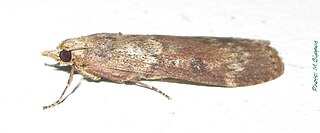Related Research Articles

Lepidoptera is an order of insects that includes butterflies and moths. About 180,000 species of the Lepidoptera are described, in 126 families and 46 superfamilies, 10 per cent of the total described species of living organisms. It is one of the most widespread and widely recognizable insect orders in the world. The Lepidoptera show many variations of the basic body structure that have evolved to gain advantages in lifestyle and distribution. Recent estimates suggest the order may have more species than earlier thought, and is among the four most speciose orders, along with the Hymenoptera, Diptera, and Coleoptera.

Galium is a large genus of annual and perennial herbaceous plants in the family Rubiaceae, occurring in the temperate zones of both the Northern and Southern Hemispheres. Some species are informally known as bedstraw.

Gryllinae, or field crickets, are a subfamily of insects in the order Orthoptera and the family Gryllidae.

Epermeniidae or the fringe-tufted moths is a family of insects in the lepidopteran order with about 14 genera. Previously they have been divided in two subfamilies Epermeniinae and Ochromolopinae but this is no longer maintained since the last group is probably hierarchically nested within the first. They are presently placed in their own superfamily but have previously been placed among the Yponomeutoidea or Copromorphoidea with which they share some features. Their systematic placement among the apoditrysian group "Obtectomera" is however uncertain. They show some morphological similarities to the "plume moths", for example the wing fringe has similar groups of scales. There are also some similarities to Schreckensteinioidea, for example spiny legs and at least in some species an open-network cocoon. The genus Thambotricha from New Zealand may be the sister group of all other extant members. The most important genera are Epermenia, Ochromolopis and Gnathifera. The group has been extensively revised and catalogued by Dr Reinhard Gaedike.

Spilomelinae is a very species-rich subfamily of the lepidopteran family Crambidae, the crambid snout moths. With 4,132 described species in 340 genera worldwide, it is the most speciose group among pyraloids.

The butterfly subtribe Euptychiina is a diverse group within the tribe Satyrini, occurring throughout Central and South America, in addition to a few species known from North America. Euptychiina is a predominantly lowland group, with the exception of one Asian taxon Palaeonympha opalinaButler, 1871 and the Andean genus ForsterinariaGray, 1973. The taxon was erected by Lee Denmar Miller.
Robert Herbert Carcasson was an English entomologist who specialised in butterflies, but also authored two field guides to tropical fishes. He joined the Coryndon Museum, Nairobi, as senior entomologist in 1956. He then became its director, under the museum's new name of the Natural History Museum from 1961 to 1968. During this time he was awarded a PhD for his studies on African hawkmoths. From 1969 to 1971 he was Chief Curator of the Centennial Museum, Vancouver, Canada. In 1972 he travelled in Polynesia, Melanesia, Australia, Malaysia, Sri Lanka, Seychelles and East Africa for production of two field guides to coral reef fish of the Indo-Pacific region. From 1973 to 1979 he was Curator of Entomology at the Museum of British Columbia. He died of cancer. Somewhat a polymath, he was fluent in a number of languages, and produced the illustrations to a number of his works, culminating in hundreds of colour and line drawings of fishes for his reef fish field guides.

Rhabdatomis is a genus of moths in the subfamily Arctiinae. The genus was erected by Harrison Gray Dyar Jr. in 1907.

Lamoria is a genus of small moths belonging to the family Pyralidae.
Rhabdatomis zaba is a moth in the subfamily Arctiinae. It was described by Harrison Gray Dyar Jr. in 1907. It is found in Mexico.
Rhabdatomis laudamia is a moth in the subfamily Arctiinae. It was described by Herbert Druce in 1885. It is found in Arizona, Guatemala, Costa Rica, Panama, Ecuador, Peru and Rio de Janeiro, Brazil.

Rhabdatomis cora is a moth in the subfamily Arctiinae. It was described by Harrison Gray Dyar Jr. in 1907. It is found in French Guiana, Panama and Costa Rica.
Rhabdatomis dognini is a moth in the subfamily Arctiinae. It was described by William D. Field in 1964. It is found in Mexico.
Rhabdatomis draudti is a moth in the subfamily Arctiinae. It was described by William D. Field in 1964. It is found in Costa Rica.
Rhabdatomis extensa is a moth in the subfamily Arctiinae. It was described by William D. Field in 1964. It is found in Colombia.
Rhabdatomis knabi is a moth in the subfamily Arctiinae. It was described by William D. Field in 1964. It is found in Mexico.
Rhabdatomis mandana is a moth in the subfamily Arctiinae. It was described by Harrison Gray Dyar Jr. in 1907. It is found in Brazil.
Rhabdatomis melinda is a moth in the subfamily Arctiinae. It was described by Schaus in 1911. It is found in Costa Rica.
Rhabdatomis pueblae is a moth in the subfamily Arctiinae. It was described by Max Wilhelm Karl Draudt in 1919. It is found in Mexico.

The Cisthenina are a subtribe of lichen moths in the family Erebidae, currently containing 428 described species.
References
- ↑ Beccaloni, G.; Scoble, M.; Kitching, I.; Simonsen, T.; Robinson, G.; Pitkin, B.; Hine, A.; Lyal, C., eds. (2003). "Rhabdatomis fasseli". The Global Lepidoptera Names Index . Natural History Museum . Retrieved May 13, 2018.
- ↑ Savela, Markku (ed.). "Rhabdatomis fasseli Field, 1964". Lepidoptera and Some Other Life Forms. Retrieved September 30, 2019.
| This Cisthenina-related article is a stub. You can help Wikipedia by expanding it. |